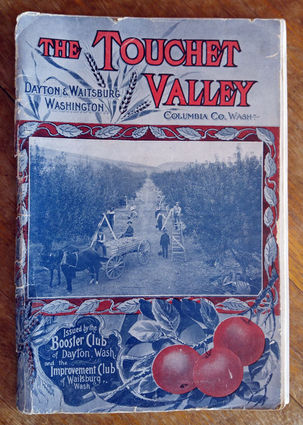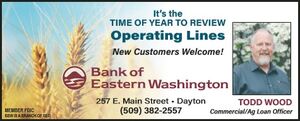KEN GRAHAM: FROM THE PUBLISHER
The Advantages of Farming in the Touchet Valley
July 27, 2017
One day a few weeks ago, out of boredom I suppose, I was rummaging through some of the dozens of old books and other materials in the back of The Times' office, when I came across a thin (64-page) soft-cover book simply titled "The Touchet Valley."
I couldn't find a date on it anywhere, except that a couple of the photos were dated 1907 and 1908. There are lots of crisp black and white photos in it.
It said it was "Issued by the Booster Club of Dayton, Wash. and the Improvement Club of Waitsburg, Wash." In the back it says: "This Booklet Planned and Executed by Sunset Magazine Homeseeker' Bureau" of Portland, Oregon.
The book, which is clearly meant to encourage people to move to the Touchet Valley, includes lots of information about agriculture in the region, as well as the features of the towns of Dayton and Waitsburg. There are photos of people fishing the rivers, motorcars driving near the fields, and many of the prominent buildings in the two towns.

The book describes the history of the area and gives extensive detail about farming conditions at the time, including yields. (Thirty bushels per acre of wheat was considered exceptional.)
At the time the book was produced, fruit orchards were coming into their own, and the book makes a big deal out of the fact that local growers were diversifying away from wheat and grain into fruit production, a trend writers predicted would continue.
Wheat was still very important, of course. Here's a passage about harvest:
"A 5000 acre farm uses eight gang plows of six to eight horses each, a steam thresher, three headers, twenty-five men and a total of seventy-five horses. A combine machine requires five men and thirty-two horses, and will cut, thresh and sack twenty acres per day."

According to the book, Columbia County "annually has furnished for the world's sustenance about 2,500,000 bushels" of wheat and barley.
Here's a longer passage about the advantages of the Touchet Valley for farming compared to other regions of the country:
[The farmer] too often has his eye on broad acres. He wants a large farm rather than a farm where the climate will enable him to make the most out of it. He is willing to buck against hard winters and uncertain rainfall, for the sake of low priced land, or land at no price. But we are in a new day. There is a new spirit abroad on the farm, a new science in the field. The up-to-date farmer knows that the elements of production are fertile soil, warmth and moisture, and he wants to be where the climate will help and not hinder; where the growing season is long, the crops sure; where there is little expense for feeding and housing stock, little drain upon animal heat and vitality on account of storms, and little loss of time on account of cold.
This gives the climate a cash value; it means more than comfort and runs back into crops, and so gets in touch with the pocket, and with the grower 's pocket book or bank account.
The "problem of production" ceases to be a problem when you can control all the factors. It then becomes a matter of skill – of knowing how. Nature helps; she holds one handle of the plow, and the farmer works hopefully, without anxieties about the weather.

This again is the setting of Touchet Valley and its chief towns. In the heart of the Inland Empire, here is also the empire of climate which draws its subjects from all lands. Here is beauty, fertility, comfort; an exquisite valley with tributary valleys, the home of crystal streams, interspersed through wide rolling uplands, in a region removed at once from the heat of the South and the cold of the North, with clear skies, yet ample rainfall, with early springs and a long growing season, with short, crisp winters, relieved of all severity by the perfumed south wind. It is a region to attract the [farmer] on its merits. Look, now. at the range of production – the variety of industries which will go on in this valley and its related uplands.





Reader Comments(0)